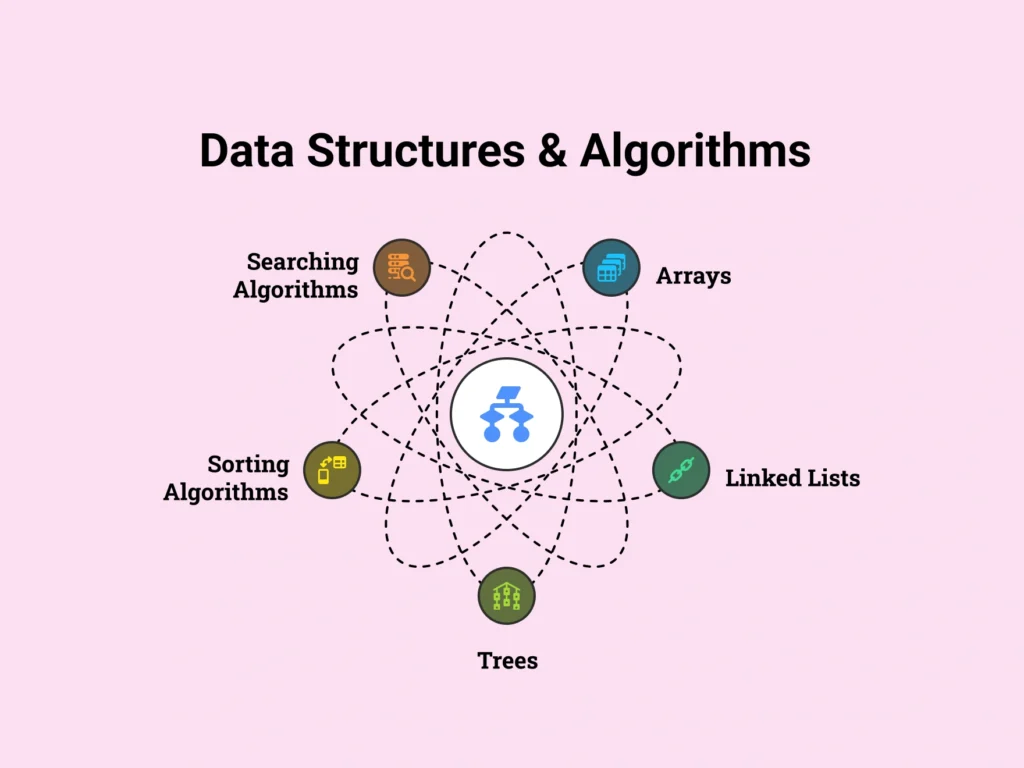Imagine you have a messy room and need to find your favorite t-shirt. You could dig through everything — or you could neatly arrange your clothes by type and color. That’s what Data Structures do — they organize your data. Algorithms are the smart steps you take to find things faster. Together, they help you solve coding problems easily and efficiently
Let’s break it down
What Are Data Structures and Algorithms?
Let’s start with the basics.
- Data Structures are ways to organize and store data so it can be used efficiently. Think of them like containers — lists, boxes, or shelves — where your data lives. Common ones include:
->Arrays
->Linked Lists
->Stacks & Queues
->Trees & Graphs
->Hash Tables
- Algorithms are step-by-step instructions for solving problems or performing tasks. They’re like recipes: “Do this, then that, then repeat until done.” Example:
->Searching for an item in a list (Linear Search, Binary Search)
->Sorting numbers (Bubble Sort, Merge Sort, Quick Sort)
->Finding the shortest path in a map (Dijkstra’s Algorithm)
Put together, DSA is about solving problems using smart ways to store and process data.
Why Should You Learn DSA?
1. It’s the Backbone of Coding Interviews
Whether you’re applying to a product company (like Google, Microsoft, Amazon) or a growing startup, DSA questions are a key part of the selection process.
Companies test your:
- Logic
- Problem-solving ability
- Efficiency of your solution
A simple question like “find the second-largest number in a list” might seem basic — but the way you solve it, and how fast, shows how strong your DSA foundation is.
2. It Makes You a Better Coder
Knowing DSA means you’re not just writing code — you’re writing efficient code.
Without DSA:
- You might take hours to solve something simple
- Your code may crash with large inputs
- You’ll struggle to understand how things work behind the scenes
With DSA:
- You’ll learn to optimize
- You’ll think before you write
- You’ll handle large-scale data with confidence
In short, DSA teaches you how to think like a real developer.
3. It Helps in Every Tech Role
Even if you don’t want to be a software engineer, DSA still helps.
- Web Developers use tree structures (like the DOM) and recursion in JavaScript
- App Developers work with stack traces and memory management
- Data Scientists process huge amounts of data using sorting and searching algorithms
- Cybersecurity professionals use graph theory for network analysis
DSA isn’t just theory — it’s everywhere in real projects.
Common topics in DSA
Here’s a roadmap of what students typically learn:
Basic
- Arrays & Strings
- Linked Lists
- Stack & Queue
- Recursion
Intermediate
- Trees (Binary Tree, BST)
- Hashing (HashMap, HashSet)
- Searching & Sorting Algorithms
- Time & Space Complexity (Big O)
Advanced
- Graphs
- Dynamic Programming
- Greedy Algorithms
- Backtracking
- Tries & Heaps
You don’t need to learn everything at once — but having a clear path helps.
How to Get Started (Even If You’re a Beginner)
You don’t need to be a genius to learn DSA. Start small. Practice regularly. Make mistakes. Learn from them.
Here’s a simple 3-step way to begin:
- Pick a Programming Language
Python, C++, or Java — any language works. Choose one and stick with it. - Understand the Concept First
Don’t rush to code. Learn why a structure is used before how to implement it. - Practice on Platforms
Websites like:
->LeetCode
->HackerRank
->Codeforces
->GeeksforGeeks
How FACE Prep Campus Makes DSA Simple
At FACE Prep Campus, we believe DSA shouldn’t be scary. That’s why our programs are designed to teach it in the most student-friendly way possible.
We offer:
- Step-by-step lessons from basics to advanced
- Live sessions and doubt clearing
- Hands-on coding problems and quizzes
- Real-world applications so you understand the “why” behind every concept
- Mock interviews and placement tests with DSA-focused questions
Whether you’re in BCA, BSc, or even BBA, we’ll help you build strong DSA skills from scratch. Our campuses across Tamil Nadu, Kerala, and Karnataka have trained thousands of students who now work in top companies — all because they built their DSA base early.
